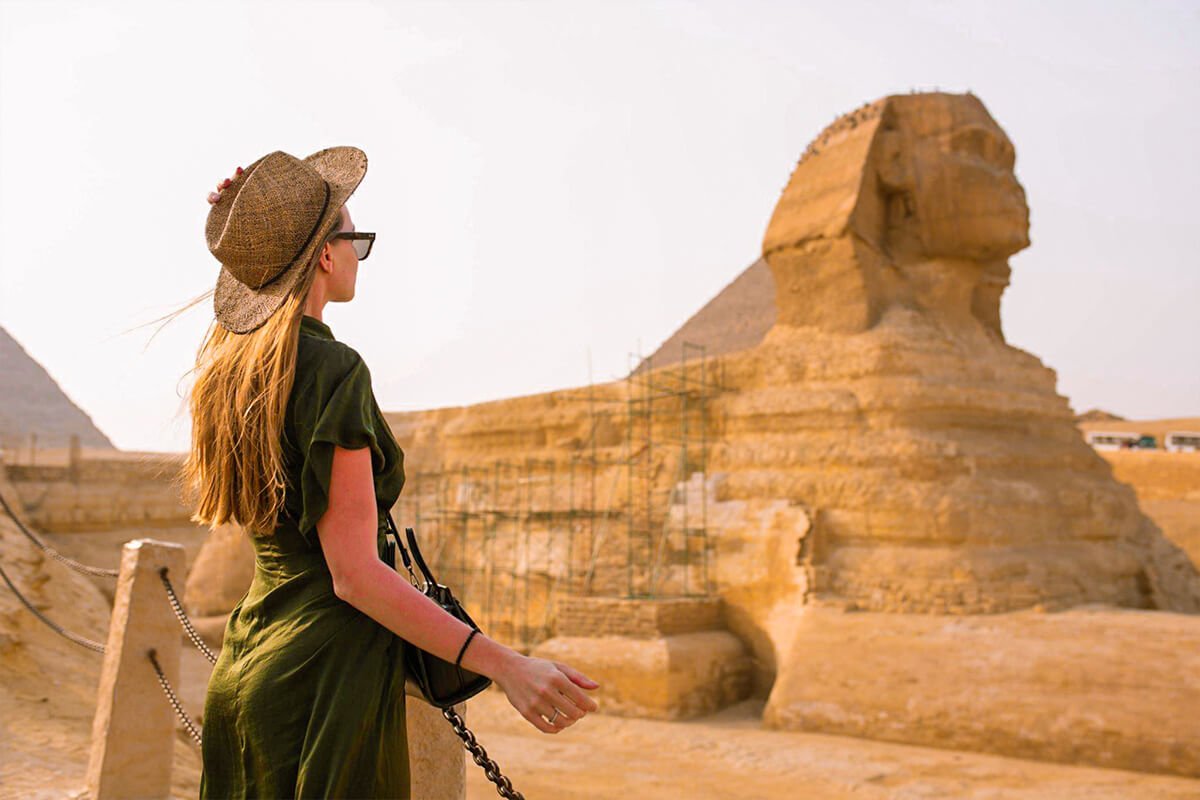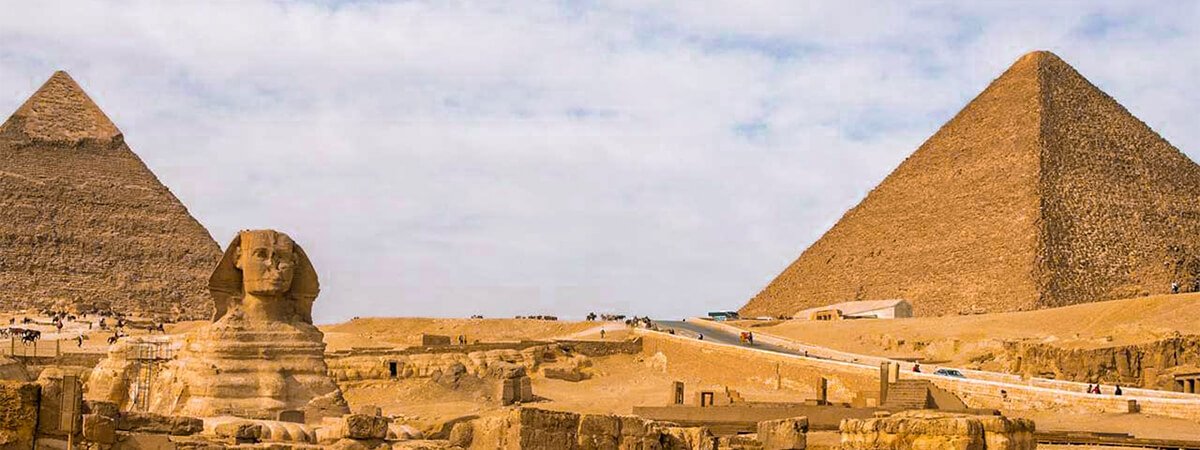Great Sphinx of Giza: A Window into Egypt’s Ancient Civilization
The Great Sphinx of Giza, a colossal enigma that has silently guarded the sands of Egypt for millennia, stands as a testament to the enduring mysteries of human history. This monumental creature, with the body of a lion and the head of a Pharaoh, is more than just a statue; it symbolizes Egypt’s rich past, a repository of secrets, and a source of endless fascination. In this detailed exploration, we will journey through time to uncover the history, hidden chambers, and symbolism of the Great Sphinx. Let’s delve into the depths of this awe-inspiring marvel.
Discover Egypt’s ancient wonders! Book your Egypt Packages now!
History Unearthed

As we dig into the historical strata, we find ourselves in ancient Egypt, where the story of the Great Sphinx of Giza unfolds. This colossal statue, carved from the living rock of the Giza Plateau, has its origins rooted in the Old Kingdom, around 2500 BC. It was Pharaoh Khafre, the ruler of ancient Egypt, who is traditionally credited with commissioning its construction as part of his funerary complex.
Khafre sculpted this famous monument from a massive limestone rock using copper and diorite tools, establishing its history. According to legend, Khafre commissioned the Sphinx, a representation of Horus, due to their resemblance. Khafre is not the only Sphinx-related historical figure; however, it is highly detailed and accurate. The mysterious observer has seen empires, centuries, and explorers’ and researchers’ interests. Napoleon Bonaparte stopped to observe this antique guard in Egypt in the late 18th century.
The Secrets Beneath the Surface
Beyond its striking exterior, the Sphinx conceals a series of mysteries beneath the surface. Over the years, archaeologists and explorers have delved into the hidden chambers and tunnels that snake through its massive body. These underground passages, shrouded in darkness and intrigue, have been the subject of extensive excavation and speculation.
Experience Egypt in a day. Your journey starts here. Egypt Day Tours.
Experience the magic of Egypt with our luxurious Nile Cruises!
The Mystery of the Missing Nose
The Great Sphinx of Giza’s missing nose has long been speculated about. Sphinx’s noses were prominent in ancient and contemporary objects and depictions, but their disappearance is noteworthy.
Can someone explain why this important facial characteristic disappeared?
Several stories and ideas surround this enigma. Urban folklore attributes the nose loss to Napoleon’s cannonball during Egypt’s occupation. Another argument is that Islamic religious iconoclasm destroyed the Sphinx. Weathering and natural degradation are more prevalent erosion sources. The mystery of the sphinx’s nose endures.
Symbolism and Significance
The Sphinx symbolizes Egyptian culture and spirituality, not just a statue. Its powerful lion body and Pharaoh’s head show worldly might and heavenly authority. The ancient Egyptians saw the Sphinx as a living divinity, not simply a statue. The sphinx’s eastward stare symbolized the sun deity Ra’s rising and sunset. It was thought to protect the Pharaohs in the afterlife from evil spirits.
Spiritually, the sphinx’s shape was significant. The human Pharaoh’s head indicated the divine order of the skies, while the lion’s unshakable power denoted earth. This dualism was important to ancient Egyptian cosmology.
The Great Sphinx of Giza and the Pyramids

The Great Sphinx of Giza does not stand alone on the Giza Plateau. It shares its home with the towering giants of ancient Egypt—the Great Pyramids of Khufu, Khafre, and Menkaure. This trio of architectural wonders forms a harmonious and awe-inspiring ensemble.
Their alignment is no coincidence; it is a testament to the remarkable precision and planning of the ancient Egyptians. The Sphinx, with its unwavering gaze, is poised in front of the Pyramid of Khafre, creating a mystical axis. The symbolism is rich: the Sphinx, guardian of the Pharaoh’s soul in the afterlife, watches over the pyramid that houses the Pharaoh’s mortal remains.
Curious about Egypt Shore Excursions? Let’s answer your questions and plan your dream trip.
FAQs the Great Sphinx of Giza
What is the significance of the Great Sphinx of Giza in Egyptian culture?
Ancient Egyptian culture reveres the Great Sphinx. It symbolizes the amalgamation of heavenly (Pharaoh) and earthly (lion) power. It represented the sun deity Ra and protected and guided Pharaohs in the afterlife.
Are there any hidden chambers or passages within the Sphinx?
Yes, there are hidden chambers and tunnels beneath the sphinx’s surface. Archaeologists have explored these, revealing inscriptions and stelae. The purpose of these hidden features remains a subject of speculation and study.
Why is the Sphinx missing its nose, and what are the theories surrounding it?
The mystery of the missing nose of the Sphinx remains unsolved. Several theories range from vandalism by Napoleon’s troops to religious heresy during the Islamic era, as well as natural erosion and decay.
How is the Sphinx being preserved for future generations?
UNESCO and the Supreme Council of Antiquities in Egypt are leading ongoing restoration and preservation initiatives that use cutting-edge technology to evaluate and safeguard the Sphinx. These efforts aim to protect it from environmental threats and pollution.
What are the most popular theories regarding the age and builders of the Sphinx?
The Great Sphinx of Giza is believed to date back to the Old Kingdom, around 2500 BC. Pharaoh Khafre is traditionally credited with commissioning its construction as part of his funerary complex. However, some alternative theories suggest even earlier origins, and the topic remains debated among Egyptologists.
Conclusion
In the heart of the Giza Plateau, the Sphinx endures as a guardian of secrets, a keeper of history, and an enigmatic guide to the mysteries of Egypt’s ancient past. Its enduring presence invites us to continue our exploration, to dig deeper into its secrets, and to appreciate the rich tapestry of human history that it represents. The Great Sphinx of Giza remains a symbol of Egypt’s enduring allure, an emblem of wonder, and an invitation to unveil the many layers of its captivating history.
Hike the Egyptian Desert: Secure Your Egypt Desert Safari Tours!



